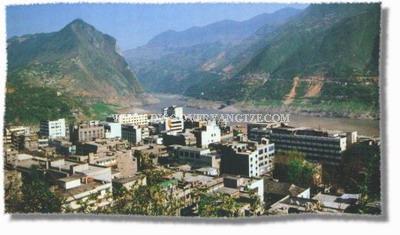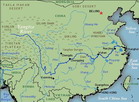2020 Yangtze River Cruise and Ferry Starting from 79 USD p.p.!
Wushan Introduction
Video A![]()
Video B![]()
Video C![]()
Wushan County is situated
above the Yangtze on the north bank and embraced
by lovely mountain peaks where flourishes the
tung tree, whose oil was used for the caulking,
oiling and  varnishing
of junks and sampans. The small town of Wuxia,with
l5,000 residents, is the county seat. Wuxia
is the starting point for boat trips up the
Daning River through the Three Little Gorges--the
main reason for making a stop at Wushan.
varnishing
of junks and sampans. The small town of Wuxia,with
l5,000 residents, is the county seat. Wuxia
is the starting point for boat trips up the
Daning River through the Three Little Gorges--the
main reason for making a stop at Wushan.
HISTORY OF WUSHAN
The town has existed since the latter
part of the Shang dynasty (c. l600--l027 BC).
ln the Warring States period (475--22l BC),
the King of Chu established a palace west of
the city. During the first century, the faith
of the Buddha had reached China and many temples
were built here, almost all the temples have
been destroyed over the years. The name of the
town originates with Wu Xian, a successful Tang--dynasty
doctor to the imperial court, who was buried
on Nanling Mountain, on the south bank opposite
Wushan. A winding path with l08 bends--leads
from the foot of the mountain to the summit
where there is a small temple. This path was
an official road through to HubeiProvince in
ancient times.
WHAT TO SEE IN WUSHAN
The streets of this long and narrow
town are named after the 12 peaks of the Wu
Gorge. The old houses are mostly two-storeyed,
with central courtyards on whose walls hang
baskets of dried medicinal herbs. The markets
supply the essentials for mountain living--back-baskets,
broad--brimmed woven hats with plastic or waxed
paper crowns to keep off the frequent summer
rains, plastic and straw sandals (best for coping
with the slippery mud after rain) and agricultural
tools. Several street dentists with pedal--driven
drills await customers. Some house-holders still
use traditional stone grinders and pounders
to make their wheat-- and rice-flour. Although
there is little Ieft of the many temples here,
one may visit, weather permitting, Gaoqiu Mountain,
to the northwest of the town. This was the site
of the King of Chu's palace and of Gaotang Temple,
built to commemorate the fairy goddess Yao Ji
and Emperor Da Yu, Controller of Rivers. According
to the Daoist (Taoist) legend, it was on this
site that Da Yu camped while cutting the three
Yangtze River Gorges.
The energetic visitor may
climb to the summit of Wushan (Witches Hill),
a two-hour hike. Worshippers still come to a
small shrine here, built within the ruins of
an old Buddhist monastery. From the summit the
views of Wu Gorge and the river are spectacular.
A less strenuous outing may be made to the newly
opened limestone cave complex in Wu Gorge high
up on the cliff face above the north bank of
the river. This involves a short boat ride from
Wushan town, an easy scramble up the rocky slope
and then a walk along the old towpath. Around
the cave complex there are the usual teahouse
and ornamental pavilions. The cave complex,
Luyou Dong, is named after a Song-dynasty official
who visited Wushan and left an appreciative
record of his stay.



